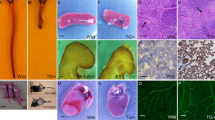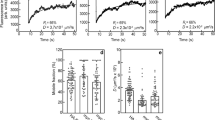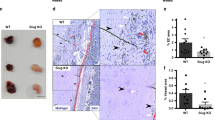Abstract
In development, tissue regeneration or certain diseases, angiogenic growth leads to the expansion of blood vessels and the lymphatic vasculature. This involves endothelial cell proliferation as well as angiogenic sprouting, in which a subset of cells, termed tip cells, acquires motile, invasive behaviour and extends filopodial protrusions1,2,3. Although it is already appreciated that angiogenesis is triggered by tissue-derived signals, such as vascular endothelial growth factor (VEGF) family growth factors, the resulting signalling processes in endothelial cells are only partly understood. Here we show with genetic experiments in mouse and zebrafish that ephrin-B2, a transmembrane ligand for Eph receptor tyrosine kinases, promotes sprouting behaviour and motility in the angiogenic endothelium. We link this pro-angiogenic function to a crucial role of ephrin-B2 in the VEGF signalling pathway, which we have studied in detail for VEGFR3, the receptor for VEGF-C. In the absence of ephrin-B2, the internalization of VEGFR3 in cultured cells and mutant mice is defective, which compromises downstream signal transduction by the small GTPase Rac1, Akt and the mitogen-activated protein kinase Erk. Our results show that full VEGFR3 signalling is coupled to receptor internalization. Ephrin-B2 is a key regulator of this process and thereby controls angiogenic and lymphangiogenic growth.
This is a preview of subscription content, access via your institution
Access options
Subscribe to this journal
Receive 51 print issues and online access
$199.00 per year
only $3.90 per issue
Buy this article
- Purchase on SpringerLink
- Instant access to full article PDF
Prices may be subject to local taxes which are calculated during checkout




Similar content being viewed by others
Change history
27 May 2010
Three duplicated references have been removed
References
Adams, R. H. & Alitalo, K. Molecular regulation of angiogenesis and lymphangiogenesis. Nature Rev. Mol. Cell Biol. 8, 464–478 (2007)
Gerhardt, H. & Betsholtz, C. How do endothelial cells orientate? Experientia Suppl. 94, 3–15 (2005)
Klagsbrun, M. & Eichmann, A. A role for axon guidance receptors and ligands in blood vessel development and tumor angiogenesis. Cytokine Growth Factor Rev. 16, 535–548 (2005)
Arvanitis, D. & Davy, A. Eph/ephrin signaling: networks. Genes Dev. 22, 416–429 (2008)
Egea, J. & Klein, R. Bidirectional Eph-ephrin signaling during axon guidance. Trends Cell Biol. 17, 230–238 (2007)
Poliakov, A., Cotrina, M. & Wilkinson, D. G. Diverse roles of eph receptors and ephrins in the regulation of cell migration and tissue assembly. Dev. Cell 7, 465–480 (2004)
Pasquale, E. B. Eph receptor signalling casts a wide net on cell behaviour. Nature Rev. Mol. Cell Biol. 6, 462–475 (2005)
Lawson, N. D. & Weinstein, B. M. Arteries and veins: making a difference with zebrafish. Nature Rev. Genet. 3, 674–682 (2002)
Lamont, R. E. & Childs, S. MAPping out arteries and veins. Sci. STKE 2006, pe39 (2006)
le Noble, F. et al. Flow regulates arterial–venous differentiation in the chick embryo yolk sac. Development 131, 361–375 (2004)
Wang, H. U., Chen, Z. F. & Anderson, D. J. Molecular distinction and angiogenic interaction between embryonic arteries and veins revealed by ephrin-B2 and its receptor Eph-B4. Cell 93, 741–753 (1998)
Gerety, S. S., Wang, H. U., Chen, Z. F. & Anderson, D. J. Symmetrical mutant phenotypes of the receptor EphB4 and its specific transmembrane ligand ephrin-B2 in cardiovascular development. Mol. Cell 4, 403–414 (1999)
Adams, R. H. et al. Roles of ephrinB ligands and EphB receptors in cardiovascular development: demarcation of arterial/venous domains, vascular morphogenesis, and sprouting angiogenesis. Genes Dev. 13, 295–306 (1999)
Shin, D. et al. Expression of ephrinB2 identifies a stable genetic difference between arterial and venous vascular smooth muscle as well as endothelial cells, and marks subsets of microvessels at sites of adult neovascularization. Dev. Biol. 230, 139–150 (2001)
Gale, N. W. et al. Ephrin-B2 selectively marks arterial vessels and neovascularization sites in the adult, with expression in both endothelial and smooth-muscle cells. Dev. Biol. 230, 151–160 (2001)
Davy, A. & Soriano, P. Ephrin-B2 forward signaling regulates somite patterning and neural crest cell development. Dev. Biol. 304, 182–193 (2007)
Taylor, A. C., Murfee, W. L. & Peirce, S. M. EphB4 expression along adult rat microvascular networks: EphB4 is more than a venous specific marker. Microcirculation 14, 253–267 (2007)
Zhu, Z., Zheng, T., Lee, C. G., Homer, R. J. & Elias, J. A. Tetracycline-controlled transcriptional regulation systems: advances and application in transgenic animal modeling. Semin. Cell Dev. Biol. 13, 121–128 (2002)
Sun, J. F. et al. Microvascular patterning is controlled by fine-tuning the Akt signal. Proc. Natl Acad. Sci. USA 102, 128–133 (2005)
Baluk, P., Hashizume, H. & McDonald, D. M. Cellular abnormalities of blood vessels as targets in cancer. Curr. Opin. Genet. Dev. 15, 102–111 (2005)
Makinen, T. et al. PDZ interaction site in ephrinB2 is required for the remodeling of lymphatic vasculature. Genes Dev. 19, 397–410 (2005)
Tammela, T. et al. Blocking VEGFR-3 suppresses angiogenic sprouting and vascular network formation. Nature 454, 656–660 (2008)
Tammela, T., Enholm, B., Alitalo, K. & Paavonen, K. The biology of vascular endothelial growth factors. Cardiovasc. Res. 65, 550–563 (2005)
McColl, B. K., Stacker, S. A. & Achen, M. G. Molecular regulation of the VEGF family–inducers of angiogenesis and lymphangiogenesis. APMIS 112, 463–480 (2004)
Zachary, I. & Gliki, G. Signaling transduction mechanisms mediating biological actions of the vascular endothelial growth factor family. Cardiovasc. Res. 49, 568–581 (2001)
Olsson, A. K., Dimberg, A., Kreuger, J. & Claesson-Welsh, L. VEGF receptor signalling – in control of vascular function. Nature Rev. Mol. Cell Biol. 7, 359–371 (2006)
Macia, E. et al. Dynasore, a cell-permeable inhibitor of dynamin. Dev. Cell 10, 839–850 (2006)
Sawamiphak, S. et al. Ephrin-B2 regulates VEGF-R2 function in developmental and tumour angiogenesis. Nature 10.1038/nature08995 (this issue)
Grunwald, I. C. et al. Hippocampal plasticity requires postsynaptic ephrinBs. Nature Neurosci. 7, 33–40 (2004)
Foo, S. S. et al. Ephrin-B2 controls cell motility and adhesion during blood-vessel-wall assembly. Cell 124, 161–173 (2006)
Deutsch, U. et al. Inducible endothelial cell-specific gene expression in transgenic mouse embryos and adult mice. Exp. Cell Res. 314, 1202–1216 (2008)
Osoegawa, K. et al. Bacterial artificial chromosome libraries for mouse sequencing and functional analysis. Genome Res. 10, 116–128 (2000)
Feil, R., Wagner, J., Metzger, D. & Chambon, P. Regulation of Cre recombinase activity by mutated estrogen receptor ligand-binding domains. Biochem. Biophys. Res. Commun. 237, 752–757 (1997)
Copeland, N. G., Jenkins, N. A. & Court, D. L. Recombineering: a powerful new tool for mouse functional genomics. Nature Rev. Genet. 2, 769–779 (2001)
Soriano, P. Generalized lacZ expression with the ROSA26 Cre reporter strain. Nature Genet. 21, 70–71 (1999)
Jat, P. S. et al. Direct derivation of conditionally immortal cell lines from an H-2Kb-tsA58 transgenic mouse. Proc. Natl Acad. Sci. USA 88, 5096–5100 (1991)
Morgan, S. M., Samulowitz, U., Darley, L., Simmons, D. L. & Vestweber, D. Biochemical characterization and molecular cloning of a novel endothelial-specific sialomucin. Blood 93, 165–175 (1999)
Lawson, N. D. & Weinstein, B. M. In vivo imaging of embryonic vascular development using transgenic zebrafish. Dev. Biol. 248, 307–318 (2002)
Acknowledgements
We thank R. Benedito, I. Schmidt, S. Hoffmann, I. Rosewell, S.M. Kuijper, F. Gisler and N. Hostettler for their help, N. Copeland and A. Eichmann for information and reagents, P. Chambon for the CreERT2 cDNA, A.L. Bermange, J.D. Leslie and J. Lewis for help with zebrafish experiments, and A. Acker-Palmer for discussions and for reading the manuscript. Cancer Research UK, the Max-Planck-Society, the German Research Foundation (programmes SFB 629 and SPP 1190) and the EMBO LTF programme provided funding.
Author information
Authors and Affiliations
Contributions
Y.W., M.E.P., M.N., C.D.N. and R.H.A. designed experiments. Y.W., M.E.P. and T.S.S. characterized mouse mutants. M.L.B. and A.S. performed zebrafish experiments, M.L.B. microinjection assays and M.N. all other cell culture experiments. A.D., U.D., L.E.B., S.A. and T.M. generated mouse mutants or lines, U.L. and A.B. the EphB4 inhibitors. Y.W., M.N., M.E.P. and R.H.A. wrote the manuscript.
Corresponding author
Ethics declarations
Competing interests
U.L. and A.B. are employed by Oncalis, the company that has developed the inhibitors ONC-101 and ONC-102.
Supplementary information
Supplementary Information
This file contains Supplementary Methods and References, Supplementary Figures 1-16 with legends and full captions for Supplementary Movies S1-S3. (PDF 8879 kb)
Supplementary Movie S1
A fluorescent time-lapse movie showing dynamics of intersegmental vessels in 27 hpf fli1-EGFP embryo injected with control morpholino. (MOV 2136 kb)
Supplementary Movie S2
Intersegmental vessels in 27 hpf efnb2a-MO-injected fli1-EGFP embryo showed few filopodia and instead blunt, bleb-like protrusions were seen on the cell surface. (MOV 2298 kb)
Supplementary Movie S3
Ephrin-B2 overexpression in single cells within a confluent monolayer of (uninjected) HUVECs. (MOV 3090 kb)
Rights and permissions
About this article
Cite this article
Wang, Y., Nakayama, M., Pitulescu, M. et al. Ephrin-B2 controls VEGF-induced angiogenesis and lymphangiogenesis. Nature 465, 483–486 (2010). https://doi.org/10.1038/nature09002
Received:
Revised:
Accepted:
Published:
Issue Date:
DOI: https://doi.org/10.1038/nature09002



